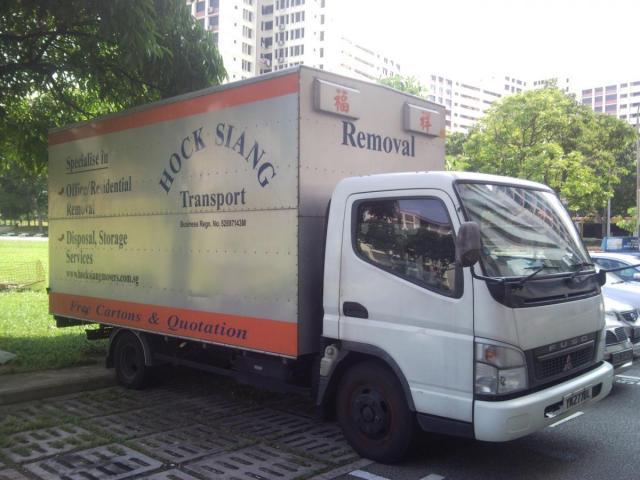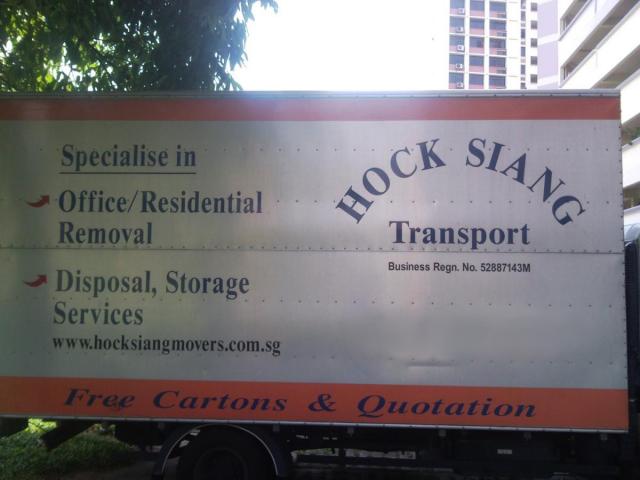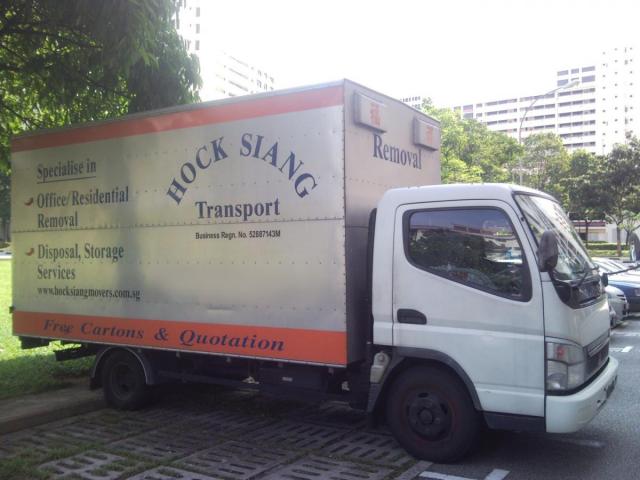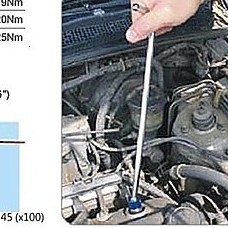Search the Community
Showing results for tags 'transport'.
-
Pupils of a primary school in Sengkang chain their bicycles to railings as they are not allowed to park them in the school. Such attitudes need to change so people are encouraged to use bicycles for transport. More than 500 cities in the world have bicycle-sharing schemes. Singapore is not among them. Although the Government announced bold plans last month to build a staggering 700km of cycling paths by 2030 - the equivalent of cycling from Singapore to Kuala Lumpur and back - that alone will not make Singapore a cycling city. We have fallen behind other cities that actively promote cycling as a mode of transport. There are various reasons why we should pedal hard to catch up. Cycling is a green option that can be an efficient people-mover for transport planners. Source: http://www.straitstimes.com/breaking-news/singapore/story/singapore-still-lacks-the-ride-stuff-20131109
- 76 replies
-
- 2
-

-
SG50 giveaway for senior citizens 1. Take your parent's senior citizen card (those age 60) and go to The Transit Link machine (MRT or bus interchange), 2. place the card n select SG voucher 3. process, then Ok 4. $50 deposited to the card from Govt. Every senior citizen, with senior citizen card will entitled every little bit helps. TGIF bros
-
"The government is consulting stakeholders on measures that can be taken to further enhance Singapore’s plan to reduce carbon emissions and promote green growth beyond 2020. As a party to the United Nations Framework Convention on Climate Change, Singapore is actively involved in ongoing negotiations to work out a new global agreement on climate change by end 2015. One key strategy is energy efficiency, especially as Singapore has limited alternative energy sources." "Share Your Views We want to hear your views on any of the following areas for action. We also welcome your perspectives on the last document – pertaining to harnessing economic and green growth opportunities in clean energy, urban solutions, research and test bedding, among others:" - from https://www.nccs.gov.sg/consultation2015
- 15 replies
-
- climate change
- transport
-
(and 7 more)
Tagged with:
-
Here we go again & the spin doctors are hard at it doing window dressing; http://www.channelnewsasia.com/news/singapore/from-april-a-2-8-hike-in/1605426.html SINGAPORE: There will be an overall increase of 2.8 per cent to public transport fares following the conclusion of the 2014 Fare Review Exercise, the Public Transport Council (PTC) announced on Wednesday (Jan 21). How the 2.8 per cent figure was calculated: By aggregating the 3.4 per cent fare adjustment quantum carried over from the 2013 Fare Review Exercise with the -0.6 per cent figure from 2014, the PTC said. But fares for senior citizen, and existing monthly travel concession prices will not rise, said the PTC. The Transport Ministry separately announced on Wednesday that fares for lower-wage workers and persons with disabilities will not increase, while the monthly concession pass for persons with disabilities will remain at S$60 per month. “In total, more than 1.1 million commuters will see their fares unchanged,” the PTC said in a press release. FARE CHANGES FROM APRIL From Apr 5 this year, adult card fares for buses and trains will increase by 2 to 5 cents, while student concessionary fares will increase by 1 cent, the PTC announced. Cash fares for adult bus and train rides will increase by 10 cents, while senior and student cash fares will remain unchanged. The prices of all monthly concession passes for adults, National Servicemen and senior citizens will remain the same, it reiterated. The PTC said bus and train fares will continue to be affordable, even for lower-income groups, as household income growth has generally outpaced household expenditure in public transport. For instance, in 2013, the second quintile (the 21st to 40th income percentile) and second decile (11th to 20th income percentile) of households in Singapore spent 2.2 per cent and 3.1 per cent of their monthly income on public transport, respectively. These were down from the 3.2 per cent and 4.6 percent, respectively, in 2003, it said. Said PTC Chairman Richard Magnus: “In approving the fare increase and deciding on the quantum, the Council made a concerted effort to minimise the impact on commuters, even to the extent of insulating some from the increase altogether. Overall, the fare adjustments for the 2014 fare exercise are lower than last year’s adjustments.” IMPACT ON OPERATORS With the fare increments, the PTC said the two public transport operators – SBS Transit and SMRT – will have to contribute S$5.5 million and S$8 million, respectively, to the Public Transport Fund. The total of S$13.5 million is S$2 million more than their contribution last year, according to the press release. The Government will utilise the Public Transport Fund to provide Public Transport Vouchers to lower-income households to mitigate the increase in their travel expenditure, it added. “I am always very concerned not only with making transport fares affordable, but making sure that our low-income families who need more assistance will be looked after,” Mr Magnus said. “The contributions to the Public Transport Fund by the operators will help defray the travel expenditure of these needy families.” "PLEASED" VULNERABLE GROUPS NOT AFFECTED BY HIKES: LUI Transport Minister Lui Tuck Yew said on Facebook that he was "pleased" that more than 1.1 million commuters, particularly more vulnerable groups like senior citizens and persons with disabilities, will not experience a fare increase. "Looking at the overall outcome of this year’s fare adjustment exercise, I believe the Public Transport Council has achieved a good balance between keeping fares affordable for Singaporeans and maintaining the viability and sustainability of our public transport system," he wrote. He added that the 250,000 public transport vouchers of S$30 will be provided to needy commuters, and the ministry aims to simplify the application process further. "We also have other plans on the meaningful use of the Public Transport Fund and I will share these with you when we are ready," the minister said.
-
COE will not going to come down.... CNA news: LTA unveils master plan to build an intelligent transport network SINGAPORE: The Land Transport Authority (LTA) on Wednesday (Aug 6) launched its master plan to improve Singapore’s transport systems and enhance commuters’ travel experience with the latest technologies. The master plan, named Smart Mobility 2030, outlines how the country will develop its Intelligent Transport Systems (ITS) over the next 15 years, LTA said. The plan, launched jointly with the Intelligent Transportation Society Singapore (ITSS), has three key strategies: Implementing smart mobility solutions to facilitate better travel for commuters and transport management; developing and adopting ITS standards for the sharing of accurate transport data and the provision of reliable, timely and relevant information services; and establishing close partnerships and fostering co-creation between the public and private sectors. Said Mr Chew Hock Yong, Chief Executive of LTA: “In the past, ITS were often infrastructure-reliant. Today, greater emphasis is placed on data collection, analytics and the availability of relevant, useful information on the move. “It is crucial to ensure that Singapore can effectively tap on technological advancements and map out the overall direction for ITS developments in the next 15 years." link: http://www.channelnewsasia.com/news/singapore/lta-unveils-master-plan/1298888.html Hmmmm............ thus that means more methods of collecting $$$$ from drivers..... Easing traffic jams with more ERPs gantries, less COE ...
- 32 replies
-
- 1
-

-
- transportation
- build
-
(and 3 more)
Tagged with:
-
Conventional wisdom tells us that public transport is more efficient than private transport. Transport executives and urban planners will rattle off data in support of this, citing, for instance, that it would take around 30 cars – with an average of two occupants per vehicle – to equal the capacity of a single-deck bus. And of course, the road space taken up by those 30 cars is much more compared to one bus. Common sense also tells us that the argument holds true. If you do a search on the Net, you will also find many counter-arguments, with most of them citing the low occupancy rate of public buses. But these arguments hinge on national figures in fairly large countries, with a mix of rural and urban bus operations. And averages often tell a strange tale. For instance, the average occupancy of public buses in the UK in 2005 was nine. Obviously, a full-sized bus with the capacity for 60 to 70 passengers isn’t going to be very efficient with only nine aboard. It is worse if you factor in the fuel consumption of a full-sized city bus (2.5km to 3km per litre). Against these numbers, the car makes a lot more sense. How will the argument pan out in a highly built-up city state such as Singapore, though? If we go by persistent complaints of crowdedness by commuters, it would seem the asset utilisation of bus fleets here is much higher. Therefore, we can infer that public transport is more efficient than private cars on this sunny island. But is it true? Based on our calculations, it is only the case during peak hours, when buses are generally operating close to full capacity. In off-peak periods, buses have an occupancy level of as low as 20 per cent. Let us look at averages, then. According to the Land Transport Authority, the average bus trip is 4.5km (2011 data). The average number of trips a leading bus company here caters to is 2.6 million a day. Over a year, it caters to 949 million trips, and it uses 130 million to 140 million litres of diesel. To work out the average fuel efficiency of each trip, multiply the annual trips by average trip distance (4.5km) and you will get 4.27 billion km. Divide that by 135 million litres and you will get 31.6km/L. That is efficient, if compared to the average fuel efficiency of an average car with a single occupant (10km/L, according to LTA data). But what if you have two or more occupants per car? The equation becomes vastly different, even if you factor in an average three per cent increase in fuel consumption per additional occupant. If you have four occupants, the car effectively becomes more fuel-efficient than the bus. If you drive a thrifty petrol-electric hybrid like the Toyota Prius, you will need only two occupants in the car to match the fuel efficiency of a bus. But the truth is that not every car here is a Prius, and quite often, it has only one or two occupants. So, the answer to improving the fuel efficiency of driving is to either car-pool or choose a fuel-efficient model like the Prius. What about road space? Even with four people per car, we would need 17 cars to match the capacity of a single-deck bus, or around 30 cars to match the ferrying capacity of a double-decker or bendy bus. Well, cars do not have to travel a fixed route or stick to a fixed schedule like buses, although the state of peak-hour traffic seems to suggest that they do. They can spread out over space and time. And if they do, they will contribute far less to congestion. For cars to be able to spread out over space and time more effectively, we’d essentially require two things: flexible working hours and decentralised urban planning. Singapore currently has neither. It would take years to change the culture to facilitate the former, and decades of innovative town planning to make the latter happen. One last thought: Can Singapore’s population of about 610,000 cars cater to the total 3.4 million bus trips that commuters make a day? With technology and a willingness to share, yes. Singapore’s car population clocks a cumulative 12.2 billion km a year – more than double the total mileage clocked by bus commuters. It is conceivable that half of this 12.2 billion km is travelled in cars occupied by only one or two persons. With a system similar to car-sharing schemes such as Car2go, Zipcar and DriveMyCar, it is possible to match the underutilised car capacity with demand from bus commuters. But until then, buses will continue to fulfil a vital role in our land transport landscape. This article was written by Christopher Tan, consulting editor for Torque.
- 3 comments
-
- torque magazine
- torque
-
(and 2 more)
Tagged with:
-
IT SEEMS obvious by now that the Government's handling of housing issues has been the most successful of several outstanding policy issues. At least, this is going by the results of a recent Straits Times survey on key election issues and their progress since the 2011 General Election. By contrast, government policies on transport issues have yet to resonate. What factors have led to the success in housing policy? What lessons can be applied to transport issues? Three points come to mind. They are: Targeting different social groups more carefully, being relevant, and implementing policies that the targeted groups can readily understand and appreciate. The challenge is to fine-tune policies to meet the needs of different groups more closely. For housing, the different groups included the first-time flat seeker, the sandwiched middle class, singles, and marginalised groups such as single mothers and divorcees with children. For first-time flat seekers, for whom a backlog had already built up, focused policies included building a record number of flats. The move was so successful that within three years, a balance was restored. The average application rate for Build-To-Order (BTO) flats fell from 5.3 per applicant in 2010 to a low of 2.9. A special subsidy was provided for households earning $2,250 or less, with eligible buyers limited to two-room or three-room flats. The Government also expanded its Special Housing Grants to households earning less than $6,500 a month. Applicants could opt for a four-room flat and still qualify for up to $20,000 more in subsidies. There was also the slew of policies related to the rental market, which made it accessible to a wider range of households (and not just lower-income groups). Competition for flats from permanent residents was reduced by making the latter wait for three years after getting their residency. Citizens felt good that they had been given priority. The Housing Board also de-linked new-flat prices from those of resale flats to stabilise BTO flat prices. There was a concerted effort to address the cash-over-valuation component. This was removed completely in the resale market. The move was particularly helpful for young couples, who could take only smaller loans and found it difficult to pay out additional cash. All these measures were announced in quick succession. The cooler market that resulted helped meet citizen expectations. Each group felt attended to, and that created a feel-good, positive attitude. But what about the transport sector? Here, commuters are challenged by overcrowded trains and buses. There is intense competition for road space among cars, buses, taxis, bicycles and pedestrians. Vehicle owners are frustrated with the prices of certificates of entitlement (COEs), which vary with market forces and the growth of the car population. Public anger is compounded when public-listed transport companies report profits, while overcrowding, rail breakdowns and delayed buses are the norm. To be fair, the Government has taken action to improve the situation. It announced several concessions for commuters. Plans are on track to have more trains and to build more lines. Bus commuters will enjoy the $1.1 billion Bus Service Enhancement Programme and efforts to make bus services more regular. For car owners, there will be a review of the carbon emissions-based vehicle scheme. Cyclists will see more bicycle racks to secure 3,000 bicycles at 32 MRT stations. Pedestrians can enjoy more sheltered linkways and lifts at 40 pedestrian overhead bridges. And yet, these excellent, far-reaching policies have made little impression on the public. Why? I believe that unlike in housing, where each measure can be seen to be directly linked to a specific group, transport measures have appeared piecemeal. Transport policymakers must clearly define the various groups they need to address and formulate policies to help each group. Policymakers also need to explain how each set of changes will improve the lot of the various commuters or motorists involved. Take one category of disgruntled commuters: Those who travel by taxi. They want changes to work in their favour immediately. Taxi charges in Singapore are among the most complicated in the world. Surcharges often lead to unintended consequences. The midnight surcharge has led to taxis "disappearing" close to midnight. Surcharges and electronic road pricing charges have kept taxis from the Central Business District, where they are most needed, especially during peak periods. And yet, cabbies complain that they often cruise with their cabs empty. In fact, a solution is nigh. Why not allow and promote the usage of mobile phone taxi-booking apps? Taxi apps offered by third parties like GrabTaxi, Easy Taxi, MoobiTaxi and Uber match cabbies directly with commuters. These apps may appear to be disruptive technology from the point of view of existing taxi companies, which have invested heavily in their call centres. But they cater to taxi commuters' needs. Then, there are public transport commuters. One segment that has been marginalised due to accessibility or high fares are the lower-income, the disabled, the elderly and students. The Government has identified this segment as needing help, and has set aside about $50 million a year for fare concessions. But are these measures enough? Besides incremental gains, there should be transformational policies to bring about the tipping point that was seen in the housing issues. Look for a nexus that resonates. For example, why not use money collected from COEs to support bus and train commuters, and to help meet the needs of special groups like the elderly, students and the disabled? COE quota premiums are a relatively stable source of revenue. For buses, why not allow more private operators like City Direct to operate bus services, to compete with the existing transport companies? Building on the growing public acceptance of transport improvements and concessions, look seriously at structural issues to bring on the kudos from commuters. For now, the policy initiatives have yet to come together in a more impactful way to resonate with people. -- ST FILE PHOTO by Basskaran Nair The writer, a retired public relations professional, teaches media and public policy at the Lee Kuan Yew School of Public Policy, National University of Singapore.
-
- opinion
- st opinion
- (and 6 more)
-
Events in recent years have underscored the need for Singapore to ramp up its transport infrastructure, as well as to rejuvenate what has already been built. Overcrowded trains and buses, long and unpredictable waiting times, and glitches in the rail system have been top grouses since as early as 2004. It did not help that Singapore's population grew by more than 30 per cent in the last decade to hit 5.4 million last year. Public transport ridership soared by more than 50 per cent over the same period to 6.36 million trips a day. Meanwhile, two major rail breakdowns in December 2011 brought into sharp focus the need for infrastructural upkeep on the back of fast-rising usage demand. The Government has responded fairly swiftly. But experts say a sustainable solution to managing public transport demand also needs measures such as increasing flexi-work arrangements, telecommuting or decentralised office hubs. On the capacity front, the Government is setting aside an estimated $2 billion to replace ageing parts in all the major rail lines together with rail operators. It is also in the process of rolling out a bus service enhancement programme - likely to cost in excess of $1.1 billion - which will boost fleet size by 20 per cent. And in January last year, it announced a slew of new lines that will grow Singapore's rail network to 360km - double its current length. This is on top of $60 billion of investments in place for ongoing projects such as the Downtown and Thomson lines. In all, transport-related projects may cost more than $150 billion. This is more than 40 per cent of Singapore's total foreign reserves last year, and seven times the 20-year transport infrastructure spending envisioned by a White Paper released in 1996. By any measure, it is a highly ambitious programme. The question is, will it be economically sustainable to go on ramping up capacity this way? This is especially when capacity is often designed to cater to peak demand, which is usually less than two hours in the morning and two hours in the evening. Hence such a network tends to be "underutilised" for the rest of the day. Average bus occupation, for instance, is only 20 per cent. Transport experts have thus called for other measures such as promoting flexible working hours and telecommuting. Attempts to stagger working hours were made back in the early 1970s to ease traffic congestion. But the campaign never did gain much traction. According to a study published by the Manpower Ministry in 2001, flexi-time was practised by only 0.3 per cent of all private-sector employees. Telecommuting was even more uncommon, with a participation rate of merely 0.1 per cent. And those who work entirely from home accounted for just 0.01 per cent of employees. While more current figures are not readily available, there are signs that flexi-time is still not widely accepted. Last June, the Transport Ministry launched a year-long free-tra-vel initiative to encourage commuters to travel just before the morning peak, following a Travel Smart initiative rolled out in October 2012 to persuade people to shift their peak-hour travel time by 15 minutes. Response was encouraging initially, with around 9 per cent of peak-hour commuters travelling earlier. But this has since fallen to 6 to 7 per cent. Certainly, the scheme has potential for improvement - perhaps even without additional tax spending (the year-long free tra-vel initiative costs $10 million). In 2004, a study by the UK Strategic Rail Authority found that train overcrowding can be eased substantially by widening the differential between peak and off-peak fares. This means giving off-peak fare discounts or wai-vers, as well as raising peak-pe-riod fares. Not only does this help the operator maintain financial viability, but the shift of peak demand also reduces the financial burden of having to run additional trains during peak hour. Analysts suggest the savings here would more than cover the cost of providing free fares. However, adjunct Professor Paul Barter, who teaches transport policy at the Lee Kuan Yew School of Public Policy, says there are limits to what flexi-time arrangements can do to flatten peak travel volumes. This is because there is "dynamic tension" between two things that people want: a regular schedule that gives them fixed times at home or with friends, and more comfortable travel. Because of this tension, people will modify travel patterns "even without the Government doing anything". And if there is less overcrowding during the peak period because some commuters have altered their travelling time, others will move in to fill the space freed up. Prof Barter, however, notes that flexi-time can contribute to shorter peaks, which range from "five to 10 minutes in Canberra to three to four hours in Jakarta". Also, if people were free to adjust their travelling time, "they would complain less", he said. He feels that many employers in Singapore "are more rigid than they need to be" in this respect. Indeed, a survey by the Land Transport Authority in 2012 found that the top reason for workers not telecommuting was that employers rarely allow it. And about 80 per cent of 1,500 people polled said they would take up flexi-work arrangements if these were made available. Finally, experts say a decentralised city is key to improving accessibility without increasing mobility. Even though Singapore had a decentralisation strategy since the 1980s, it has not gained much traction - until now. "There was a time when it was felt that having a big CBD (Central Business District) was good for the economy," recalls Prof Barter. "But I think it is better to have many sub-centres across the island." Now, several sub-centres are in the works, including Jurong Lake District, Woodlands and the Kallang Riverside. All these will allow more people to live near where they work, and work near where they play. Meanwhile, cities the world over are increasingly looking to "soft" demand management measures to spread out peak loads on transport systems. In 2008, Melbourne started offering free travel to commuters who arrive at the CBD before 7am. It led 23 per cent of commuters to travel out of peak hours. Monetary measures are not the only way to temper peak demand. In the run-up to the 2012 Olympics, London embarked on a public education and awareness campaign to prepare for the foreseeable surge in travel demand. The programme included reducing the need to travel, spacing out journeys, shifting to walking or cycling, as well as re-routing to less busy routes. The result was encouraging. Despite record ridership - London Underground, for instance, carried 4.52 million passengers on Aug 9, the highest in its history - the transport network coped well. Elsewhere, Abu Dhabi has spelt out a transport mobility management strategy as it prepares for a possible trebling of its population by 2030. It includes park-and-ride, car-sharing, flexible working hours, and telecommuting plans. All these are in place in Singapore, even if they lack scale. But things may be changing. Last year, the Urban Redevelopment Authority unveiled plans for a 700km cycling path network by 2030 - thrice the length of the current network. And URA chief planner Lim Eng Hwee leads by example: He cycles to work.
- 2 comments
-
- public transport
- st opinion
-
(and 7 more)
Tagged with:
-
Professional Mover To Assist You During Relocation Hock Siang Transport has been engaged on daily basis for consumers who needs movers for their home & office relocation. Extremely responsive and meticulous at the small little things we handle , rest assured that be it moving your furniture around from places or storing your goods for instance, we are highly capable to sorting it out to your preference and meet your needs. With upholding every customer as our priority with service at our mind, you can be at ease and need not to worry as we deliver efficiently and hassle free. Pricing is widely reasonable comparative to the market movers provided and is very cost effective to your wallets. Setting your mind at ease as we move . Why Choose Us We dedicate ourselves to consistently providing the highest quality of service in order to achieve customer satisfaction every time. More than just logistical aspect of moving , we takes great honour in the crucial part that we play in the advancement of our customers lives and businesses . We always handle all our transactions with much care and consideration . We value the trust that is given to us by our customers . That is why we strive to provide value-added services that let them feel like their needs are met and their expectations are exceeded . Release your burden and hire us now to shift your belongings safely in time ! We Offer All Transportation & Delivery Services , Delivery , Unpacking Assembly & Positioning Of Furniture Dismantle Of Import / Export Furniture Exhibits Delivery Free Packing Of Valuables Furniture House & Office Moving Local Household Effects Removal (Door To Door) Office / Factory / Warehouse Relocation Piano & Organ Moving Professional Cargo Packing Removal Of Packing Debris Safe Box Removal Wrapping & Packing Of All Items Wrapping material is an essential element in preserving the integrity of your chattels. With Hock Siang Transport , we are meticulous in the selection of the most suitable material for your chattels . Set Up An Appointment With Us Now ! The first thing you need to do is to set up an appointment with us . The appointment is for us to come to your place to evaluate and provide an estimate costing for you . No obligation to engage us . As a professional moving company , we will be more than ready to do a site visit to get a clear picture of your house or office so that we can plan the move . Don’t Hesitate ! Call Us Now For A Free Quotation ! Hock Siang Transport Blk 806 , Hougang Central , #03-146 , Singapore 530806 Tel : 98341434 Email : [email protected]
-
Soon Seng Transport Service 2000 Soon Seng Transport Service has been marked as an experienced professional movers in Singapore and we are in business since 1990, with our very first office at 1 Colombo Court. Over the years in the line of relocation service and in order to meet the need for cater of storage facility, our company has recently shifted to our present address at Hillview Terrace, an office with warehouse facility. Having our own warehouse, it allows a safe and secure storage facility, with 24 hours security guard on duty, specifically designed to meet your storage need for household or office effects. With our own warehouse storage facility, there is no worry of your items to be moved due to lease expiration. WITH SOON SENG TRANSPORT – WE OFFER PROFESSIONAL SERVICE IN RESIDENTIAL MOVERS COMMERCIAL MOVERS DELICATE INSTRUMENT MOVE (SPECIALIST IN PIANO , ORGAN, SAFE) RELOCATION SERVICE IT INFASTRUCTURE RELOCATION STORAGE SPACE & DISPOSAL SERVICE FULL PACKAGING AND PARTIAL PACKAGING SERVICE Our packing crews are also trained to handle packing and relocating of piano, antique furniture, fragile items, etc.. and our aim is to provide our best and efficient service to need all customer satisfaction as we feel that is the best advertisement. Soon Seng Transport Service 2000 Address: 31 Bukit Batok Cresent #01-20 S(658070) Phone: 63684988 Website: www.soonsengtransport.com.sg
-
- 2
-

-

-
- house mover
- transportation
-
(and 5 more)
Tagged with:
-
Hi! any bro here is sales line covering Malaysia? got a job offer that expected to travel into M'sia (Muar, Melaka, KL) almost every week, 2 to 3 days in each one trip. they give $800 (need to give CPF). Only M'sia toll, parking and Malaysia petrol top up can claim. Like to know what is the standard market rate for the transport allowance? need to consider the increased risk factor when going into M'sia. my main concern is : 1) faster wear & tear 2) vehicle breakdown or towing (who pays?) 3) accident in Malaysia (excess, insurance loading foot ourselves?) 4) theft & car stolen ( surely insurance won't cover everything) 5) coffee $$$ Thanks!
-
Why is it that reducing waiting and in-vehicle times does not seem to make public transport users happy? The debate on improving public transport service quality and affordability is unending. Suggestions have ranged from having more competition to ensuring efficiency to zero fares and even the nature of public transport itself. These discussions, however, skirt the central issue. A journey by public transport is actually a chain of trips. A trip from an origin to a destination typically consists of walk time to the bus stop or MRT terminal, wait time, in-vehicle time and access time to the final destination. The time of each component will vary by mode, distance travelled, trip purpose (i.e. office commute, shopping, social) and by time of the day. When a transfer between modes is involved, this makes the total time travelling by public transport unattractive compared to travel by car. In recent months, laudable efforts have been made to improve wait and in-vehicle times of bus and MRT rides by increasing the fleet of buses and reducing the time between train arrivals. In 2008, the Land Transport Master Plan (LTMP) stated: "Average public transport journey times will be reduced from 1.7 times of that by car today to 1.5 times by 2020 to make public transport more competitive relative to cars. "Our end in mind is to have a public transport system that will be so attractive that users with choice, i.e. those who can have access to cars, will say that 'my other car is a bus or train'." The 2013 LTMP focuses on addressing the four main components of the typical public transport journey - the first and last kilometre, wait time and in-vehicle time. This is being done through improvements such as seamless connectivity from home to terminal, more public transport infrastructure and investments in operating assets. A 2001 study by Professor Mark Wardman at the University of Leeds' Institute for Transport Studies in the UK has shown that walking and waiting times are perceived as being between two and three times more annoying than in-vehicle time regardless of the level of traffic congestion. These assessments will vary across circumstances, such as a journey to work versus participation in leisure activities. It will also vary when compared with in-vehicle time by car, bus or the MRT. The number of transfers, whether involving crossing a bridge or a long walk in-between, will also influence the way people perceive walk and wait times. So will the extent to which access involves pedestrian delays at junctions and crossings. In fact, the level of irritation caused by walk and wait times can be 1.5 to 8 times the perceived value of in-vehicle time. The point, therefore, is to view accessibility and mobility as a total experience. Minimising in- vehicle and wait times is just one aspect of the experience. It involves making the trip a pleasant one from the time a person steps out of the home to the time he arrives at his final destination. Making public transport the backbone of a city's mobility requires giving the public transport user priority. It entails minimising pedestrian delays and creating walkway connectivity within the city. But it will also mean making it more costly to drive into and park within the Central Business District. Electronic Road Pricing and limited parking facilities will lead to a more efficient allocation of scarce city space. Prioritising public transport may mean the development of "closed urban areas" where buildings are interconnected by sheltered pedestrian walkways. Walking - and perhaps cycling - will be a safe, healthy, viable and a delightful experience. Within the closed urban area, cars will not get priority. The "first and last kilometre" will then be an attractive link in the public transport trip. The 2013 Land Transport Master Plan and the just-released Fare Review Mechanism Committee Report are steps in the right direction if effectively implemented. Further, the Fare Review Mechanism Committee Report, in addressing the needs of the economically disadvantaged, enhances accessibility to jobs and centres of human capital development such as institutions of education. This together with real-time public information about public transport schedules might just nudge car users at the margin to use public transport. It might also lead to the spreading of the peak period when commuters choose to travel at alternative times, ease human congestion at MRT stations and bus terminals, and make the journey by public transport a pleasant experience. -- ST FILE PHOTO by Anthony Chin The writer is associate professor of transport economics, deputy director of the Singapore Centre for Applied and Policy Economics, and director of the Economics Executive Programme, NUS.
-
The LTA recently revealed a Land Transport Masterplan which maps out enhancements to the public transport as well as road management. We look at the some intrinsic details and finds out what they can mean to us. Naturally, one of the key highlights of the plan lies in the public transport sector. Both the rail and road systems will receive substantial boost, such as extending bus services to more areas, giving more priorities to buses, as well as an ambitious plan to double the island's rail network by 2030. For a moment, the plan does seem to have hit the nail on head. But we reckon there is more than meets the eye. Our rail system has been plagued by frequent service faults and disruptions. Even with the current network, train operators have been struggling to keep maintenance up to the mark, and statistics have proven this point. There were four cases of service disruptions in October alone, and no less than nine cases in previous three months. On that point, imagine the amount of workload on the maintenance with the doubled network, which will likely lead to more disruptions if all things remain constant. Then, there is the mindset of the local commuters. A study has shown that locals still prefer private mode of transport. And if nothing is done to adjust this preference, the enhanced public transport network will just be a 'white elephant'. Next, the plan aims to address road congestion by putting ERP gantries on major roads (Bukit Timah Road, Holland Road etc.). At this instance, one question springs to our minds: If the current 71 gantries placed on expressways and arterial roads have limited effect on congestion, how will adding gantries to major roads help? And hence, the big question remains: Do you think the master plan will succeed?
-
I really doubt... Its personal space, comfort and the control that will be very hard to get through our public transport system. On the contrary, it is the cost$ that will push drivers to give up driving altogether. Two in five basic bus services improved since BSEP launch The Land Transport Authority (LTA) said 248 new buses have been added on the road under the Bus Service Enhancement Programme (BSEP). That is nearly half of the 550 buses that the government has pledged to add to the public transport system as part of the programme. Under BSEP, aimed at expanding public bus capacity and improving bus service levels, the government will foot the bill of over S$1.1 billion for these 550 buses while public transport operators will pay for another 250 buses. So far, more than S$90 million has been spent. Giving a one-year report on the programme, LTA and public transport operators SBS Transit and SMRT said in total, 111 existing bus services - or two in every five basic bus services - have been enhanced and 14 new bus services introduced. In a joint statement on Monday morning, they indicated these improvements have enhanced the connectivity of Singapore's bus network. In addition, they have shortened waiting times by three to five minutes for some existing bus services. Based on the analysis of ticketing and GPS data, this has reduced the number of bus services with persistent crowding during peak period by about 40 per cent. LTA said the bulk of the remaining buses that the government has agreed to add will be rolled out by the end of 2014 instead of 2016. LTA also said it will be tapping private bus operators further to augment its resources. Transport Minister Lui Tuck Yew said: "(As a result of the BSEP,) what we have seen therefore, is that there has been a shorter waiting time for commuters, less crowded, and basically a better commuting experience for everybody. "Because we are accelerating the programme, we therefore expect that the expenditure is going to be a bit higher and faster than what we originally envisaged. When we originally put up the S$1.1 billion figure, we did not expect to involve the private operators in such a large way. "So, we've got to look at those figures and after a couple of years, we would be in a much better position to be able to see whether the S$1.1 billion is indeed sufficient to last us for the entire duration of the 10 years." Meanwhile bus service 651, which plies from Jurong West direct to the city and is operated by a private bus operator, was launched on Monday. LTA will also work with private bus operators to operate short services during peak hours. This includes localised routes in estates that take residents to nearby transport nodes. These services will complement the existing feeder bus services operated by the public transport operators. LTA will call a tender for these short services later this year. In addition, two more new services will be implemented to further improve connectivity in areas like Taman Jurong and Bukit Panjang by the end of this year. And nine more new City Direct bus services will be progressively rolled out from January next year. Even though there are more buses on the roads, reactions from commuters have been mixed. One commuter said: "The waiting time is actually quite fast -- it's between two and five minutes sometimes during peak hours. But if it's during non-peak hours, normally it's five to 10 minutes, which is quite reasonable." Another commuter disagreed, and said: "Sometimes you can't even get into the buses because it's jam packed, especially during peak hours." The government will review the Bus Service Enhancement Programme after 2014 to see what other improvements are needed.
-
Hi, I had sold my car. And need to take public transport with my baby (7months). How to safely carry her in taxi or bus?
-
http://www.straitstimes.com/breaking-news/...t-year-20130613 wah peng.... free train ride then... now new bus service.... So the rest of ppl that work outside of CBD , esp those that need to travel from East to West , or West to East , no need subsidies and no need additional bus service...
-
Actually starting this poll for fun, for I know which of the 5 will get the most.
-
Let's be honest.. If we were to have a virtually almost perfect public transport, No breakdowns, no delays, free of charge (citizen only, sorry! Others please pay up), reach everywhere on the island, comfy, fast and efficient, etc. Would you ditch your car?
-
Talking to wifey this morning, Gonna go see Orchard lightup tomorrow night. Thinking about taking public transport so don't have to worry about parking. Then wifey say something interesting - "You realise it will cost us more right?" So I go and calculate To take train down the return journey will be $13-78. Like that, can drive and pay parking / ERP also cheaper. So where is incentive to take public transport? Individually the fares are cheap enough, but when you have a family it is surprising how quickly it can add up. What can be done? I dunno. Maybe have "family packages" - register your EZLINK card, if all cards at a single address, when travelling together the fare is capped? Would that work to enourage more Public Transport?
- 81 replies
-
- Encouraging
- Public
-
(and 1 more)
Tagged with:
-
Anyone taken this survey before? They way they phrase it is quite a surprise to me.
- 22 replies
-
- concept
- encouraging
- (and 4 more)
-
Will you joint the 20% of the car owners who took part in the survey, to give up owning a car or forgo driving and switch to public transport? Or you are indeed one of the 20% who has intention to give up driving or owning a car, to switch to public transport. http://www.zaobao.com.sg/sp/sp120729_003.shtml English Translation (Only on those more relevant to the topic) According to a poll by Lianhe Zaobao showed that close to 20% of car owners took part in the survey would forgo driving if COE prices continue to rise further. However, around 40% of car owners say that they will still buy a new car even if COE prices continue to hit new highs. The remaining 40% are undecided and more than half from this group of people are likely to sell or scrap their car upon reaching 10 years old, only 30% of them will renew the COE for their existing car to continue driving. Those who prefer buying new cars are of the view that pre-owned vehicles are costly to maintain as compared to the new cars, which are relatively cheaper to maintain. A real estate agent interviewed said that he has lost confidence on pre-owned cars. He revealed that he has owned 3 pre-owned cars previously and each of his pre-owned cars had been causing him lots of maintenance problems and he had to spent almost $500 monthly on the car maintenance. He said he would never buy a pre-owned car again, as these 2nd hand cars had given him lots of problems. He now owns a 4 years car, which was a new car at the time of purchase, and he spent only a few hundred dollars yearly to maintain this car. Transport researchers were surprised to find that 20% of respondents said they would forgo owning a car and take public transport should COE prices continue to rise. They noted that with even a 5% fall in the traffic volume, Singapore would see significant improvements in its road traffic conditions, especially at peak hours.
-
Guys, Do the people here know about the Public Consultation on the Land Transport Masterplan? http://talk2lta.lta.gov.sg/ltmp I am thinking for all the TCSS here, shall we have a discussion online in MCF, and agree on some plans and submit a MCF submission to LTA that is signed by all those who participated in the discussion. Reason for this is 1) for all the TCSS here, it will be nice for MCF to do something "useful" 2) If we managed to agree on a set of policies and signed by a significant number of people, it might be more "convincing" 3) the discussion process is probably interesting (to me at least) Just a thought... I might need a moderator to lead this effort if people think it is worth it. What do you guys think?
- 9 replies
-
- Public
- Consultation
-
(and 3 more)
Tagged with:
-
Here is your chance to share your idea and voice your frustration on current transportation policies to LTA. LTA is now embarking on another 5-year plan to review and update its 2013 Masterplan There are 3 discussion topics: - How can we improve your public transport experience? - How can we make better use of scarce road space in land-constrained Singapore? - How can we create an inclusive transport system, and one that supports environmental sustainability and liveability? http://talk2lta.lta.gov.sg/ltmp
- 10 replies
-
- Public
- Consultation
-
(and 3 more)
Tagged with:
-

Cars Vs Public transport in singapore. (Your Views)
Xtremee posted a topic in General Car Discussion
Hi guys, i am sure u guys are aware of the pros and cons of Car drives and Public transport users. Recently cost of purchacing cars have gone up again! However must not for get about the frequent breakdown and highly congested public transport. With current situation i want to hear the Public's viewpoint of Users of Cars and Public Transport in Singapore






























